We can evolve water-conserving turf reduction to community-enhancing rehydration: How to shift from minimizing a problem to maximizing potential
by Brad Lancaster
To address dwindling Colorado River water supplies, upon which many communities depend, western cities are committing to reducing ornamental grass and its associated water use (figures 1 and 2). That’s a start that tries to minimize a small part of the larger problem, but we can easily do much better if we also strive to maximize the potential already freely at hand.
The potential. In the desert city of Tucson, Arizona more rain falls on the surface of Tucson in an average year of rainfall than all its residents consume (indoors and outdoors) of municipal water in year (but the vast majority of that rain is wastefully drained away, resulting in Tucson replacing the drained rainwater with endangered Colorado River water pumped over 300 miles and 3,000 feet uphill).
To tap that potential, we need to plant that rain within—not drain it away from—our landscapes.
So, along with reducing water use by switching from high-water-use plantings/turf to low-water-use plantings, we must simultaneously better manage, recycle, and increase the availability of the waters already freely at hand.
We can inexpensively and very effectively make subtle shifts to the topography of the vegetated landscapes in our built environments that enable them to plant the rain and other free on-site water sources, in a way that we cycle more water within, and give back more water to, our shared watershed than we extract from it. By doing so we can irrigate the plantings (once established—establishment takes one to three years) solely with free, on-site waters—no imported water from the Colorado River or elsewhere being needed (figure 3). No costly pumps or mechanical water treatments are needed; gravity can distribute the water free of charge, while vegetation and other soil life provide bioremediation or living filtration for free. This reduces downstream flooding in wet times, and the effects of drought in dry times, while also improving water quality and helping recharge local water tables and the flows of rivers.
This builds capacity, health, and resilience; rather than just reducing harm.
Compare the different approaches in the three images below…
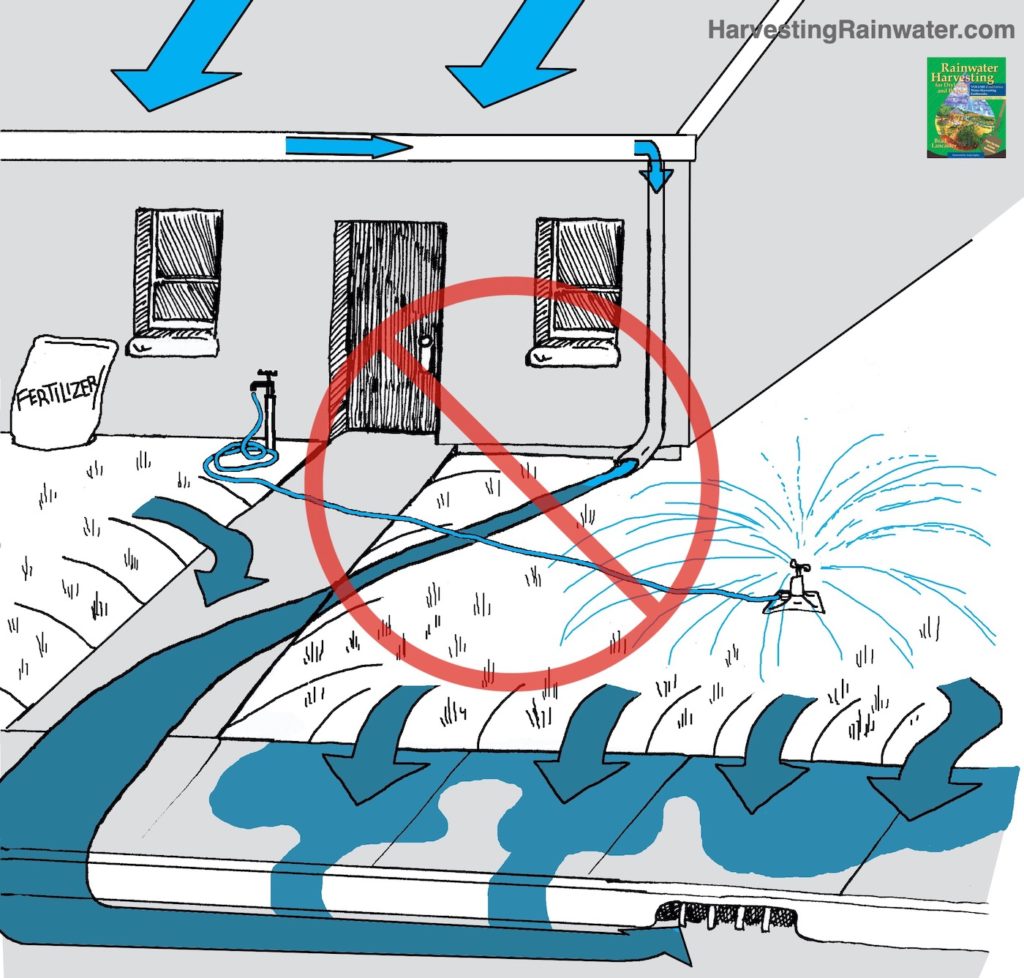
A draining, convex landscape of high-water-use ornamental turf grass that is dependent on sprinkler irrigation with imported water.
Arrows denote water flow from roof, landscape, and lawn over watering.
Reproduced with permission from Rainwater Harvesting for Drylands and Beyond, Volume 2, 2nd Edition. Illustration by Joe Marshall
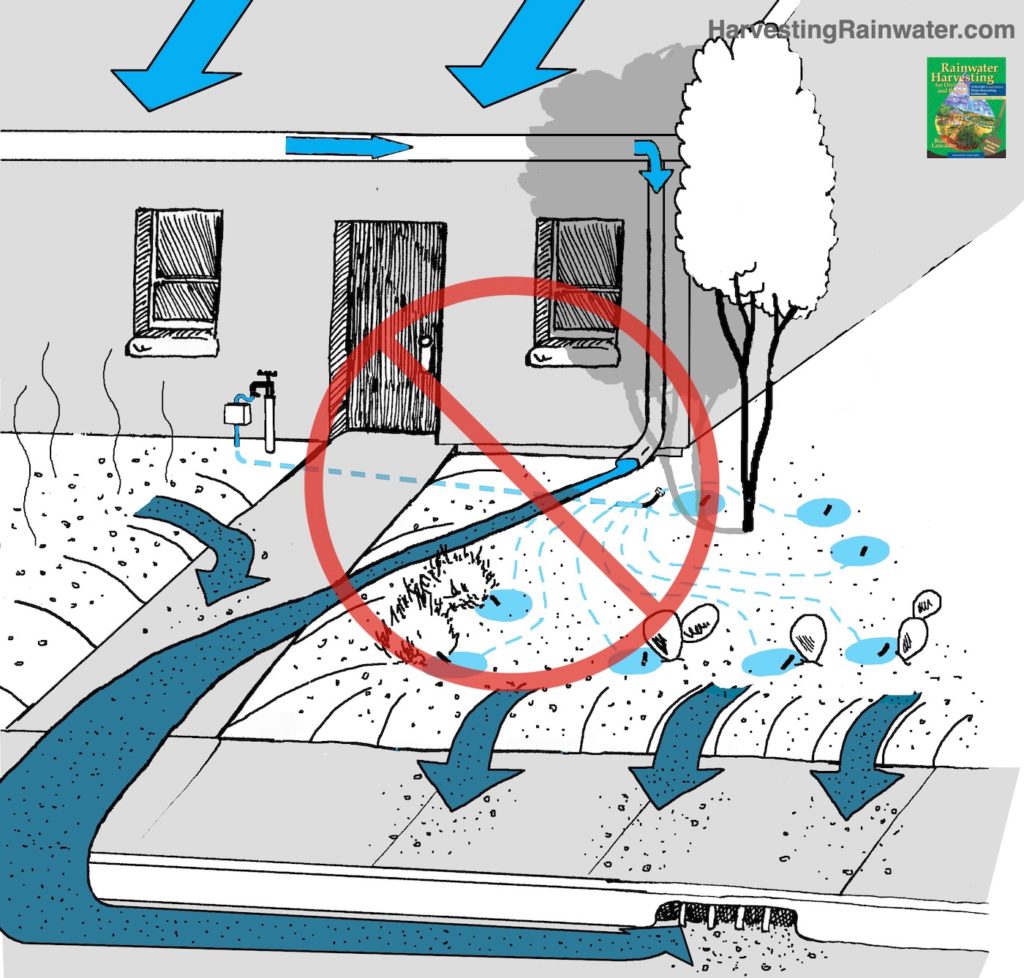
A draining convex landscape mulched with gravel (that increases ground-level temperatures) and planted with low-water-use ornamental vegetation that is still dependent on imported water via drip irrigation, while draining the majority of free on-site waters away.
Arrows denote water and sediment flow from roof and landscape.
Reproduced with permission from Rainwater Harvesting for Drylands and Beyond, Volume 2, 2nd Edition. Illustration by Joe Marshall
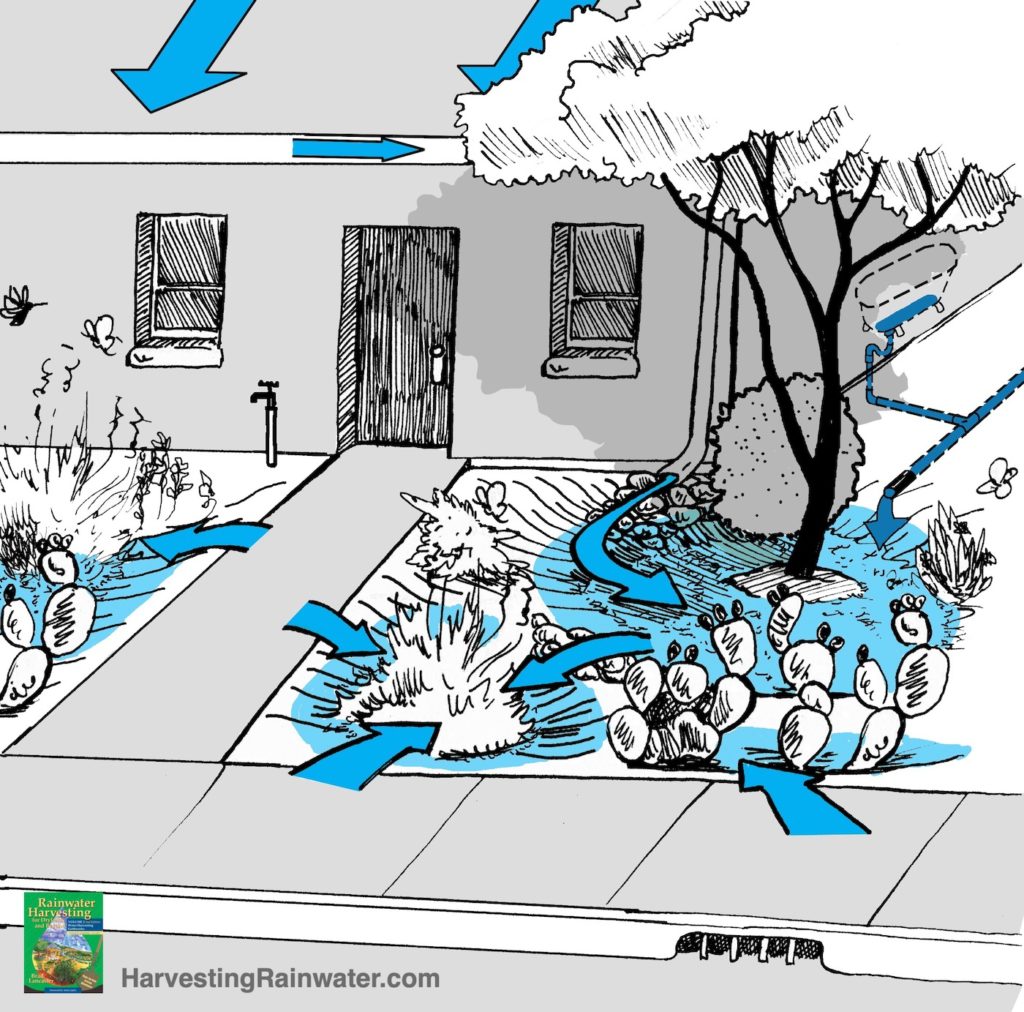
A harvesting concave landscape mulched with organic matter (that enhances soil life, water infiltration into the soil, and water holding capacity within the soil) and planted with low-water-use (food-, medicine-, and wildlife habitat-producing) native vegetation.
Once established, this rain garden thrives solely on captured rainwater and runoff turned runon—no imported water is needed—though harvesting on-site greywater boosts performance further still.
Arrows denote the flow of free, on-site waters into the landscape.
Reproduced with permission from Rainwater Harvesting for Drylands and Beyond, Volume 2, 2nd Edition. Illustration by Joe Marshall
Cash for grass turf reduction rebate programs and ordinances limiting ornamental turf are celebrated, but they frustrate me and dry out the watershed if they only change the plant material, but leave dysfunctional, dehydrating topography in place that wastefully drains and evaporates free, on-site waters away, which is made worse if the replacement landscape emphasizes importing expensive mined rock and gravel (that increase surface temperatures) over passive cooling vegetation (figure 2).
Alternatively, a water-functional topography increases available rainfall even in drought, by redirecting stormwater runoff from adjoining hardscape surfaces to run in and soak in to the planted landscape (figure 4). Local organic-matter mulch turns green “waste” of leaf drop and cut up prunings into a fertile ground covering resource held in place within the water-harvesting basins where increased moisture helps speed up the transformation of the mulch into sponge-like humus.
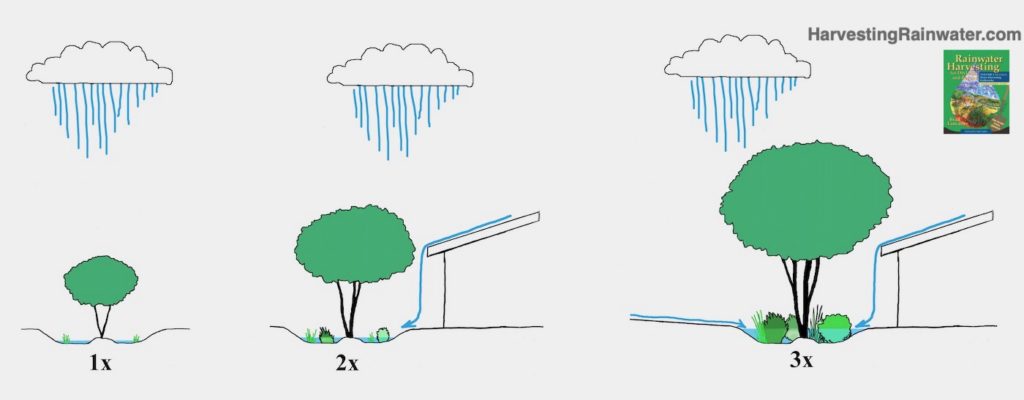
Reproduced with permission from Rainwater Harvesting for Drylands and Beyond, Volume 2, 2nd Edition. Illustration by Joe Marshall
Puddles and mosquitoes are not a problem, because the living sponge of vegetation and healthy soil life in the rain gardens rapidly infiltrates the water subsurface where less is then lost to evaporation.
Flooding is not an issue because an overflow route is always planned and designed so the overflow water can be beneficially used as a resource (figure 5).
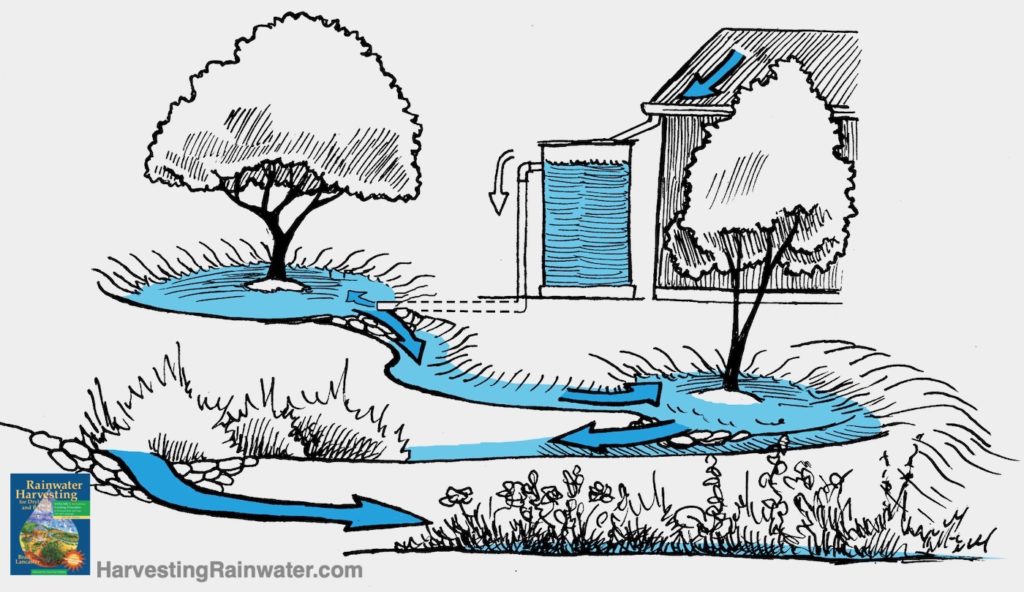
Reproduced with permission from Rainwater Harvesting for Drylands and Beyond, Volume 1, 3rd Edition. Illustration by Joe Marshall
Simple calculations and plant water demand estimators (see the full-color editions of Rainwater Harvesting for Drylands and Beyond, Volumes 1 and 2) enable you to size your rain gardens and plan your plantings so they thrive within your free, on-site waters budget. It is easiest to succeed with native plants that have adapted to your local climate, soils, and wildlife over millennia (figure 6).
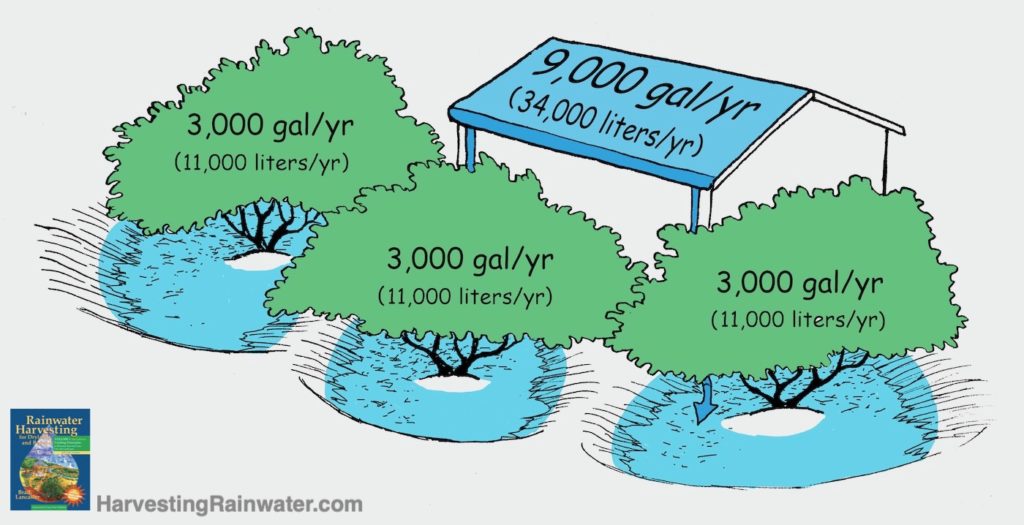
Reproduced with permission from Rainwater Harvesting for Drylands and Beyond, Volume 1, 3rd Edition. Illustration by Joe Marshall
When planting more water-needy, non-native vegetation, other previously wasted on-site waters such as greywater and air conditioning condensate can also be directed to plantings in times of no rain (figures 3 and 7).
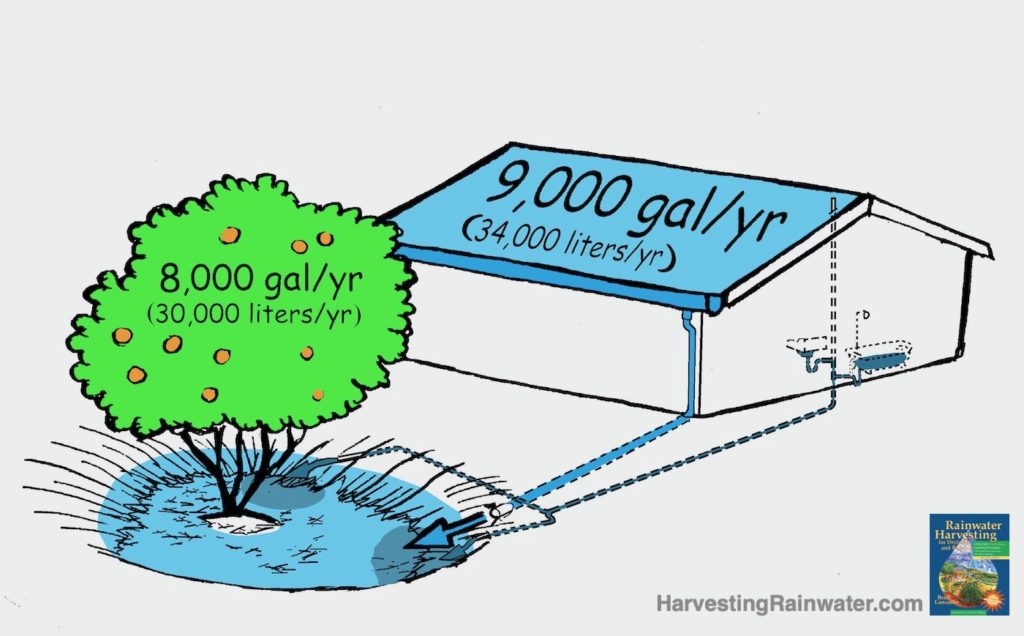
Reproduced with permission from Rainwater Harvesting for Drylands and Beyond, Volume 1, 3rd Edition. Illustration by Joe Marshall
Water-harvesting tanks are also an option (figure 8), though I typically start with the passive water-harvesting earthworks or rain gardens because they cost no more than the price of a shovel, as long as you are doing the work. The water-harvesting earthwork(s) or rain garden(s) reduce your need for a tank (and so they reduce the size and cost of a tank), and the rain gardens are ideal places to direct tank overflow water where it can be used as a resource.
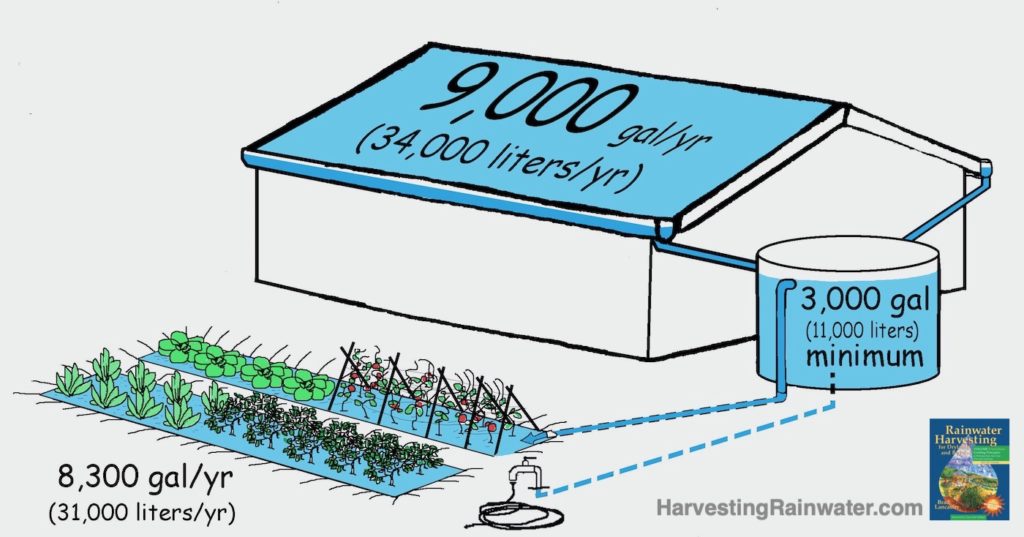
Reproduced with permission from Rainwater Harvesting for Drylands and Beyond, Volume 1, 3rd Edition. Illustration by Joe Marshall
The main goal of this water abundance path—is to use less water than nature renewably provides while consistently improving water quality, flow, and dependability and as a result, decreasing and even eliminating groundwater pumping and the need to import water. The first step is to harvest more rainfall in our landscapes than we use from municipal water or private wells. This leads to a more sustainable hierarchy in the household and community management of our water resources in which:
• Rain is our primary water source;
• Greywater is our secondary source;
• Municipal water or groundwater from wells is strictly a supplementary source used only in true times of need.
To easily achieve this within the landscape and gardens, plant the rain before you plant by creating microtopography that maximizes the amount of water you keep on your site and infiltrate into your soil and vegetation. There are far more ways of doing this for different contexts—see the following links for real life examples: residence, steep site, within water channels, urban, rural, in-street, street-side, and parking lots and garages).
Plant both the rain and greywater before you plant a more water-needy plant (figures 3 and 7). Rain gardens can also harvest all other desired “waste” waters turned “resource” waters.
And if you’ve already planted your plants without planting the rain, plant the rain and other free on-site waters now (see Rainwater Harvesting for Drylands and Beyond, Volume 2, 2nd Edition for retrofit strategies and examples).
New study finds the pooling effect of rain garden basins essential to drought-proofing water-conserving and water-harvesting landscapes
Some rain planting policies
The City of Tucson, Arizona mandates that commercial landscapes need to meet at least 50% of their landscape’s irrigation demand with passively harvested water (within rain gardens). All new roads and major road renovations must harvest at least a half-inch rainfall’s worth of water in the road-side and in-road landscapes/rain gardens. Residential rainwater harvesting systems can qualify for up to a $2,000 rebate.
That’s a start in incentivizing the planting of rain and stormwater, but we need to go further.
The same (or more) should also be required/incentivized for all multi-family residences, the front yards of all tract home developments, roadside landscapes of parks and schools, and all plantings within and adjoining any parking lot or driveway. And we need to continually enhance our guidance on, and enforcement of, these policies, along with our collaborations with contractors and other businesses and service providers.
And with that, I’ve only just begun…
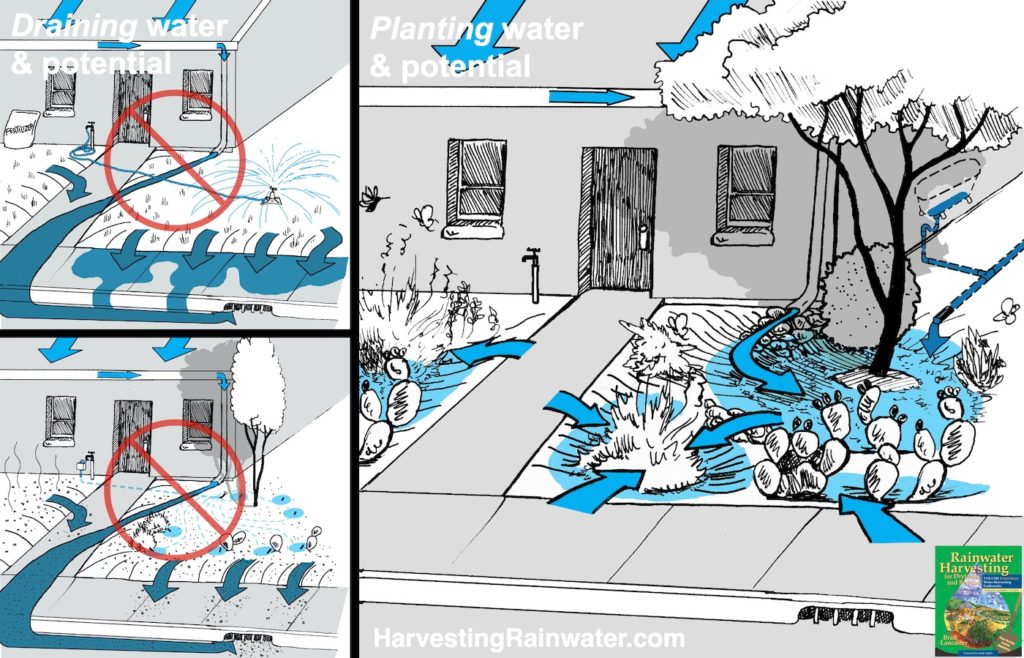
For more information
Check out the full-color editions of the books Rainwater Harvesting for Drylands and Beyond, available at deep discount, direct from me the author, at HarvestingRainwater.com, which also has many real-life case studies, free resources, videos, and more.
And for neighborhood-based efforts creating flood-controlling, rain-irrigated native food forests see NeighborhoodForesters.org.
See the new, full-color, revised editions of Brad’s award-winning books
– available a deep discount, direct from Brad:

Volume 1
This it the book to introduce you to the potential of planting your free, on-site waters to grow regenerative abundance.
It shows you how to assess your site and create an integrated design.
Includes plant water demand estimator in a plant appendix giving you tips on what and where to plant.

Volume 2
This book gives you step-by-step instructions on how to plant rain, stormwater, greywater, dark greywater, and condensate in a diverse array of different water-harvesting earthworks or rain gardens for a diverse array of different contexts.
Many case studies and examples to instruct and inspire.
